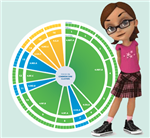K-12 Mathematics
-
The K-12 mathematics program within Southern Lehigh School District will provide opportunities for all students to develop the ability to independently apply mathematical knowledge and skills to real-world situations. A robust and coherent curriculum will prepare students to think and reason mathematically while requiring them to demonstrate a deep understanding of mathematics. Students will develop critical thinking, problem solving, innovation, collaboration, and communication skills. A focus will be placed on using mathematics as a key to understanding the world, in order to meet the challenges of a dynamic society.
K-12 Mathematics Philosophy
-
Mission Statement for K-12 Mathematics:
Empowering students to problem solve, innovate, and communicate mathematically to understand the world around them and seize tomorrow’s opportunities.Guiding Principles for K-12 Mathematics:
Students will be able to...- be flexible mathematical thinkers by generating and connecting various mathematical representations and concepts.
- look for, recognize, and use structure and patterns.
- apply and transfer mathematical knowledge, skills, and strategies to new and real world situations.
- reason abstractly and quantitatively.
- engage in mathematical discourse and communicate thinking using appropriate mathematical language and vocabulary.
- make sense of problems and persevere in solving them.
- reflect and revise thinking to ensure reasonable solutions.
- model with mathematics.
- attend to precision.
- select and use appropriate tools strategically in order to deepen understanding of concepts.
- construct viable arguments and critique the reasoning of others.
- demonstrate both a conceptual understanding of mathematics and procedural fluency.
Best Practices for K-12 Mathematics:
Teachers will...- promote the joy, wonder, and beauty of mathematics.
- develop a learning environment that promotes productive struggle, risk taking, self-efficacy, and resilience.
- use and promote the use of a variety of mathematical representations (i.e. concrete, representational, abstract, verbal, and contextual).
- use goals to engage students in discussion about what they are learning and why they are learning it.
- use focused and leveled questioning to engage students in higher order thinking.
- provide opportunities for students to engage with authentic problem solving and challenging tasks.
- provide opportunities for students to acquire conceptual and procedural knowledge.
- provide opportunities for students to construct knowledge through mathematical discourse .
- provide opportunities for students to make sense of problems, analyze their thinking, and revise their work.
- provide opportunities for students to make connections with prior knowledge and build upon current understanding.
- help students develop metacognitive awareness.
- provide students with mathematical tools (including manipulatives), model their use, and encourage students to select appropriate tools strategically.
- provide opportunities for students to develop number sense.
- reinforce the use of precise mathematical language and vocabulary.
- help students embrace and learn from their mistakes.
- provide differentiated classroom instruction driven by assessment to meet the needs of all learners.
K-12 Mathematics Planned Course Documents
K-12 Mathematics Scope and Sequence Documents
enVisionmath 2.0 Resources
-
 Sign In - Pearson Realize offers a wealth of resources to support both students and parents at home with enVisionmath 2.0 content. Parents can access Pearson Realize through their child's account, given by the teacher. https://sso.rumba.pearsoncmg.com/sso/login?profile=realize&k12int=true&service=https%3A%2F%2Fwww.pearsonrealize.com%2Fcommuni
Sign In - Pearson Realize offers a wealth of resources to support both students and parents at home with enVisionmath 2.0 content. Parents can access Pearson Realize through their child's account, given by the teacher. https://sso.rumba.pearsoncmg.com/sso/login?profile=realize&k12int=true&service=https%3A%2F%2Fwww.pearsonrealize.com%2Fcommuni Pearson Math Game Center - Online thinking games to motivate and enhance learning. Intelligently interactive, each game challenges students to apply previous math leanring and build to more complex concepts. https://media.pearsoncmg.com/curriculum/math/gamecenter/en_US/ca-grade-1.html
Pearson Math Game Center - Online thinking games to motivate and enhance learning. Intelligently interactive, each game challenges students to apply previous math leanring and build to more complex concepts. https://media.pearsoncmg.com/curriculum/math/gamecenter/en_US/ca-grade-1.html enVisionmath 2.0 Alignment to Standards - When students connect ideas, they deepend their understanding. enVisionmath2.0 is organized into clusters of connected topics and lessons. The following link will allow you to see the standards addressed in each Lesson and Topic, as well as the way the standards are clustered together. https://www.pearsonschool.com/env_wheel/
enVisionmath 2.0 Alignment to Standards - When students connect ideas, they deepend their understanding. enVisionmath2.0 is organized into clusters of connected topics and lessons. The following link will allow you to see the standards addressed in each Lesson and Topic, as well as the way the standards are clustered together. https://www.pearsonschool.com/env_wheel/

